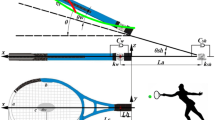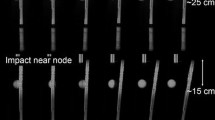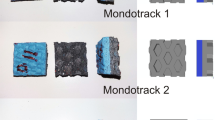Abstract
The literature, both scientific and commercial, already reports a large number of papers dealing with the dynamic properties of sports racquets and their influence on possible injuries caused to athletes. In particular, tennis players can suffer for the so called “tennis elbow” which is believed to depend also on the damping properties of racquets. In order to reduce injuries, to provide a better playing feeling, and to increase performances, producers of tennis equipment are keen to present ameliorations to their products, sometimes with great commercial echo. The same companies, together with a number of smaller firms, also sell minor components (grip, over-grip, strings dampers and so on) which should increase damping and limit annoying vibrations. The interest on the subject is also documented by the number of patents, easily acquired on the web. In this paper, the effects on the dynamic properties introduced by the granular damping technology and by a silicone ring are investigated. A finite element model of a generic racquet has been defined to study the effects of a silicone ring placed just above the end of the handle, i.e., at the base of the throat, and also to define the static stiffness of the structure. This stiffness and the forces computed by a discrete element model, aimed at quantifying the interactions among granules contained in two small boxes fixed to the racquet, have been introduced in a simplified single degree of freedom system to explore the effectiveness of the granular solution. Numerical conclusions are confirmed by experimental results, obtained by analysing (both in time and frequency domains) the free response of a racquet repeatedly impacted by tennis balls.










Similar content being viewed by others
References
Allen T, Hart J, Spurr J et al (2010) Validated dynamic analysis of real sports equipment using finite element; a case study using tennis rackets. Procedia Eng 2:3275–3280
Banwell GH, Roberts JR, Halkon BJ et al (2014) Understanding the dynamic behaviour of a tennis racket under play conditions. Exp Mech 54:527–537
Bird GA (1994) Molecular gas dynamics and the direct simulation of gas flows. Clarendon Press, Oxford
Brody H (1989) Vibration damping of tennis rackets. J Appl Biomech 5:451–456
Casiano MJ (2016) Extracting damping ratio from dynamic data and numerical solutions
Daoud M (2016) Etude Expérimentale et Modélisation par la méthode des éléments discrets de l’amortissement dans les matériaux granulaires. PhD thesis, Université Paris Saclay (COmUE); École nationale d’ingénieurs de Sfax (Tunisie)
Dullien FA (2012) Porous media: fluid transport and pore structure. Academic press
Ewins DJ (2009) Modal testing: theory, practice and application. John Wiley & Sons
Fang X, Tang J, Luo H (2007) Granular damping analysis using an improved discrete element approach. J Sound Vib 308:112–131
Fasana A, Ferraris A, Airale AG et al (2018) Oberst and aging tests of damped CFRP materials: new fitting procedure and experimental results. Compos B Eng 148:104–113
Fluendo (2021) Fluendo: il Dampener rivoluzionario per Tennis e Padel. In: Fluendo Tennis. https://www.fluendotennis.com/. Accessed 7 Dec 2021
Grosso P, De Felice A, Sorrentino S (2021) A method for the experimental identification of equivalent viscoelastic models from vibration of thin plates. Mech Syst Signal Process 153:107527
Hatze H (1992) The effectiveness of grip bands in reducing racquet vibration transfer and slipping. Med Sci Sports Exerc 24:226–230. https://doi.org/10.1249/00005768-199202000-00011
Hennig EM (2007) Influence of racket properties on injuries and performance in tennis. Exerc Sport Sci Rev 35:62–66
Hennig EM, Rosenbaum D, Milani TL (1992) Transfer of tennis racket vibrations onto the human forearm. Med Sci Sports Exerc 24:1134–1140
Hong Y, Bartlett R (2008) Routledge handbook of biomechanics and human movement science. Routledge
International organization for standardization (2019) ISO 6721-1:2019. In: ISO. https://www.iso.org/cms/render/live/en/sites/isoorg/contents/data/standard/07/31/73142.html. Accessed 24 Jan 2022
Kleinoder H, Yue Z, Mester J (2000) Results of investigations on kinetic mass in tennis rackets. Springer, Charm
Kozicki J, Donze FV (2009) YADE-OPEN DEM: An open-source software using a discrete element method to simulate granular material. Eng Comput 26(7):786–805
Kudu FN, Uçak Ş, Osmancikli G et al (2015) Estimation of damping ratios of steel structures by operational modal analysis method. J Constr Steel Res 112:61–68
Li FX, Fewtrell D, Jenkins M (2004) String vibration dampers do not reduce racket frame vibration transfer to the forearm. J Sports Sci 22:1041–1052
Maia NMM, e Silva JMM (1997) Theoretical and experimental modal analysis. Research Studies Press
Nie J, Wei X (2011) On the use of material-dependent damping in ANSYS for mode superposition transient analysis. In: pressure vessels and piping conference. pp 239–244
ProKennex (2021) ProKennex - Cutting-edge technologies for the future of tennis. https://www.prokennex.eu/en/technologies.php. Accessed 9 Dec 2021
Ratnam R, Jones DL, Wheeler BC et al (2003) Blind estimation of reverberation time. J Acoustic Soc Am 114:2877–2892
Rudratpatna VR kinetic racquet tests. https://cdn.website-editor.net/8fab8a6f846a401391edc165381d908f/files/uploaded/Kinetic%20Test.pdf. Accessed 24 Jan 2022
Segesser B (1981) Sportverletzungen und Sportschäden im Ellbogenbereich
Takeshima M, Asakura T (2020) Numerical simulation of vibration damping by granular materials. Appl Acoust 162:107189
Taraborrelli L, Grant R, Sullivan M et al (2019) Materials have driven the historical development of the Tennis Racket. Appl Sci 9:4352
Tsuji Y, Tanaka T, Ishida T (1992) Lagrangian numerical simulation of plug flow of cohesionless particles in a horizontal pipe. Powder Technol 71:239–250
Tweten DJ, Ballard Z, Mann BP (2014) Minimizing error in the logarithmic decrement method through uncertainty propagation. J Sound Vib 333:2804–2811
Yade (2022) Overview — Yade 3rd ed. documentation. https://yade-dem.org/doc/. Accessed 24 Jan 2022
Żurawski M, Zalewski R (2020) Damping of beam vibrations using tuned particles impact damper. Appl Sci 10:6334
Acknowledgements
The authors wish to thank Mr. Fabio Bosello for the incitement at first studying the subject and for his valuable help when performing the experimental tests.
Author information
Authors and Affiliations
Corresponding author
Ethics declarations
Conflict of interest
The authors declare that they have no known competing financial interests or personal relationships that could have appeared to influence the work reported in this paper.
Additional information
Publisher's Note
Springer Nature remains neutral with regard to jurisdictional claims in published maps and institutional affiliations.
Rights and permissions
Springer Nature or its licensor (e.g. a society or other partner) holds exclusive rights to this article under a publishing agreement with the author(s) or other rightsholder(s); author self-archiving of the accepted manuscript version of this article is solely governed by the terms of such publishing agreement and applicable law.
About this article
Cite this article
Fasana, A., Montanaro, P., Simone, S. et al. Experimental and numerical analysis of damping properties of tennis racquets. Meccanica 57, 2821–2833 (2022). https://doi.org/10.1007/s11012-022-01601-w
Received:
Accepted:
Published:
Issue Date:
DOI: https://doi.org/10.1007/s11012-022-01601-w




